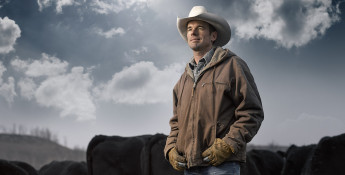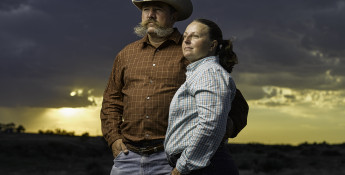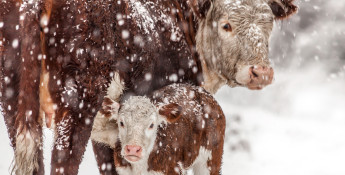By John Schlageck on November 8, 2017
Caring for cattle in the Flint Hills
This rancher wants her herd to be athletic

Like bison that grazed the Flint Hills hundreds of years before them, cows (female cattle who have given birth) and heifers (female cattle who have not given birth yet) on the Blythe Angus Ranch eat the same nutritious grass native to this unique ecosystem. During this year’s grazing season, the grass has been spectacular.
The Blythes welcome years like 2017 when the grassland yields plenty to eat and cows and heifers grow fat and sassy. Even with such an outstanding growing season, the Morris County ranchers work hard and smart to implement careful pasture management, cow herd health and love of their livestock to ensure this family ranching enterprise continues.
Debbie Lyons-Blythe oversees the day-to-day activities of the cow and heifer herds on the family ranch founded in 1890. Son, Trent, serves as her right-hand man.
“Cows are magic,” Lyons-Blythe says. They take something we can’t eat (grass) and make a nutritionally dense source of protein.”
The Blythe family takes seriously the care of these living creatures. They respect each and every cow or heifer and understand the cattle depend on them for a healthy, contented life. The Blythes know if they nurture their herd they may give birth to a dozen calves during a 12-year period.
Cows and heifers receive all the grass they can eat. The Blythes hire a nutritionist to help ensure their stock receive the appropriate diet including mineral supplements, salt and whatever else they require.
A veterinarian also serves as an integral part of their management strategy. This ensures flies and other pests are kept in check and diseases or injuries can be treated.
During the last three decades the Blythes have honed their management program to a science. They know what works, do it every year and do it right.
“We want our girls to stay healthy, athletic and reproduce throughout their lifetime,” Lyons-Blythe says. “If our cows and heifers don’t have good feet and legs they can’t walk around the pasture, and if they can’t walk around the pasture they can’t eat the grass and drink the water.”
But giving them the best care and nutrition doesn’t mean the cows are pampered.
“We want them to work hard,” the Morris County rancher says. “We want to make sure we raise good, solid stock that will breed back and produce a healthy calf as well.”
With their cow and heifer herds spread out across 11 pastures, it’s difficult to visit them all, every day. Still the Blythes remain vigilant in the oversight of their livestock and check on them at least once a week.
As the winter months move in, cows and heifers will be fed top-quality hay and graze on a cover crop of turnips, radishes and oats. During bitter cold days when temperatures fall to single digits or below zero, the Blythe herd requires more fuel to stay warm and healthy.
“This provides them with carbs, gives them energy and can put a bit of fat on their bones,” Lyons-Blythe says. “We feed ‘em up a little extra when it’s cold. That’s also when we break out the alfalfa hay.”
As temperatures warm up and the weather becomes milder, hay with a higher nutrient quality is fed to the cows, especially after they calve.
“Making sure our cattle remain healthy throughout the seasons requires a whole lot of attention,” Lyons-Blythe says. “We sample all of our cattle feed so we know what the nutritional value is and we know how much to feed them.”
In October more than 200 head of first-calf heifers left the Blythe pastures and were purchased by other ranchers needing replacement stock. Most of the heifers sell by word of mouth.
There’s a good feeling in letting them go, Lyons-Blythe says. These girls will go to work for somebody else and do well.
Most of the heifers go to repeat customers. They travel from ranches across the United States to purchase Blythe cattle.
And while there’s nothing she’d love better than driving her pickup through a herd of contented cows grazing the lush Flint Hills grass in summer, Lyons-Blythe knows there remains additional work to be done telling her family’s story about caring for cows and heifers.
Eight years ago, the Morris County rancher became a full-time blogger telling consumers her story and answering questions about her vocation.
“I want to make one connection every single day with one consumer,” Lyons-Blythe says. “I do so by social media, face-to-face conversation, by phone, text or with my blog.”
Blythe hosted a food blogger’s tour of her ranch last June. This opportunity allowed the bloggers to walk through the native prairie, see wildflowers among the grass and visit the cow herd.
Such close encounters allow urbanites to visit with the Morris County rancher and commune with the native ecosystem while learning firsthand about the cattle who depend on the grass for their well-being.
Lyons-Blythe remains convinced these activities result in life-long connections.
“While I realize we’re not going to change everyone’s mind on how we grow their food, my goal is to make them think critically about this process,” she says.
The Morris County rancher knows the importance of answering consumer questions about farming and ranching.
“If we aren’t the voice for our vocation, someone else will be,” Lyons-Blythe says. “And they won’t tell our story like we want it done – knowledgeably and truthfully.”
Check out Debbie Lyons-Blythe at www.KidsCowsandGrass.com.






